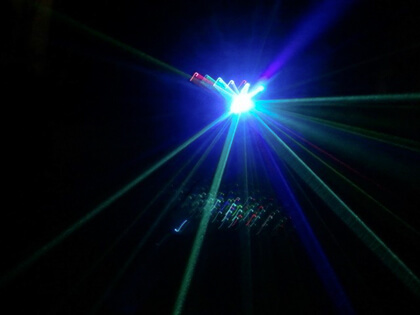Lasers and laser systems are divided into four major classifications according to their potential to cause biological damage to the eye or skin. The purpose of these classifications is to warn users of the hazards associated with the laser relative to the Accessible Emission Limits (AEL). These limits are based on laser output energy or power, radiation wavelengths, exposure duration, and cross-sectional area of the laser beam at the point of interest.

The ANSI Laser Classifications Are As Follows
Class I: cannot emit laser radiation at known hazard levels (typically continuous wave: CW 0.4 µW at visible wavelengths). Users of Class I laser products are generally exempt from radiation hazard controls during operation and maintenance (but not necessarily during service).
Since lasers are not classified on beam access during service, most Class I industrial lasers will consist of a higher class (high power) laser enclosed in a properly interlocked and labeled protective enclosure. In some cases, the enclosure may be a room (walk-in protective housing) which requires a means to prevent operation when operators are inside the room.
Class I.A.: A special designation that is based upon a 1000-second exposure and applies only to lasers that are “not intended for viewing” such as a supermarket laser scanner. The upper power limit of Class I.A. is 4.0 mW. The emission from a Class I.A. laser is defined such that the emission does not exceed the Class I limit for an emission duration of 1000 seconds.
Class II: Low-power visible lasers that emit above Class I levels but at a radiant power not above 1 mW. The concept is that the human aversion reaction to bright light will protect a person. Only limited controls are specified.
Class IIIA: Intermediate power lasers (CW: 1-5 mW). Only hazardous for intra-beam viewing. Some limited controls are usually recommended.
NOTE: There are different logotype labeling requirements for Class IIIA lasers with a beam irradiance that does not exceed 2.5 mW/cm2 (Caution logotype) and those where the beam irradiance does exceed 2.5 mW/cm2 (Danger logotype).
Class IIIB: Moderate power lasers (CW: 5-500 mW, pulsed: 10 J/cm2 or the diffuse reflection limit, whichever is lower). In general Class IIIB lasers will not be a fire hazard, nor are they generally capable of producing a hazardous diffuse reflection. Specific controls are recommended.
Class IV: High power lasers (CW: 500 mW, pulsed: 10 J/cm2 or the diffuse reflection limit) are hazardous to view under any condition (directly or diffusely scattered) and are a potential fire hazard and a skin hazard. Significant controls are required of Class IV laser facilities.
The IEC Laser Classifications Are Summarized As Follows
Class 1: Class 1 lasers are safe under all operating conditions. There is no risk to eyes or skin. Class 1 lasers may consist of a higher power laser housed within an enclosure.
Class 1M: Class 1M lasers are not capable of producing hazardous exposure under normal operating conditions, but may be hazardous if viewed with the aid of optical instruments.
Class 2: Low power lasers (CW: up to 1mW) in visible wavelength range (400-700nm). The aversion response will protect the eye from damage due to direct exposure. There is no hazard from exposure to diffuse radiation.
Class 2M: Low power lasers (CW: up to 1mW) in visible wavelength range (400-700nm). Class 2M lasers are not hazardous under normal operating conditions because of the aversion reaction. Class 2M lasers may be hazardous if viewed with the aid of optical instruments.
Class 3R: Moderate power lasers (CW: up to 5mW) for visible wavelengths (400 to 700nm). Up to a factor of five over maximum allowable exposure of Class 2 lasers for other wavelengths. Class 3R lasers are considered low-risk but potentially hazardous.
Class 3B: Moderate power lasers (CW: up to 500mW, Pulsed up to 30mJ) in wavelength range of 300nm to far infrared. Direct eye exposure to Class 3B lasers is hazardous; however, diffusely scattered radiation is generally safe. Direct exposure to skin is a potential hazard.
Class 4: High power lasers (CW: above 500mW). Direct and diffusely scattered radiation from Class 4 lasers is hazardous to the eye. Direct exposure of Class 4 lasers are also a potential skin hazard and fire hazard.
Precautions for Safe Operation of Class 3b and 4 – Medium and High Power Lasers
- Establish a controlled area for laser operation: limit access to those trained in the principles of laser safety.
- Post warning signs prominently near entrances to the laser operation area.
- Set up shields to prevent the beam from escaping the laser operation area.
- Set up a target to block the beam after it passes through the operating area.
- Keep the protective cover on the laser head during operation.
- Enclose the beam path whenever possible.
- Keep the laser beam either above or below eye level.
- Do not look at the beam directly or as reflected by a mirror or polished surface. When working with a class 4 laser, do not expose skin to beam.
- Safety glasses must be worn at all times when working with a class 4 laser.
- When working with a class 4 laser, contact your laser safety officer for operation of the laser activation warning system.
Laser Safety Terms
Accessible Emission Limits (AEL) – the maximum accessible level of laser radiation permitted within a particular laser class.
Aversion Response – Blinking of the eye, or movement of the head to avoid exposure to a bright light.
Continuous Wave (CW) – Continuous emission of radiation as opposed to short bursts.
Controlled Area – An area where the occupancy and activity of those within is subject to control and supervision for the purpose of protection from radiation hazards.
Diffuse Reflection – Change of the spatial distribution of a laser beam when it is reflected in multiple directions by a rough or matte surface.
Intrabeam Viewing – Exposing the eye to all or part of a laser beam.
Maximum Permissible Exposure (MPE) – The level of laser radiation to which a person may be exposed without hazardous effect or adverse biological changes in the eye or skin.
Nominal Hazard Zone (NHZ) – The space within which the level of the direct, reflected, or scattered radiation during normal operation exceeds the applicable MPE.
Specular Reflection – A mirror-like reflection of a laser beam.
